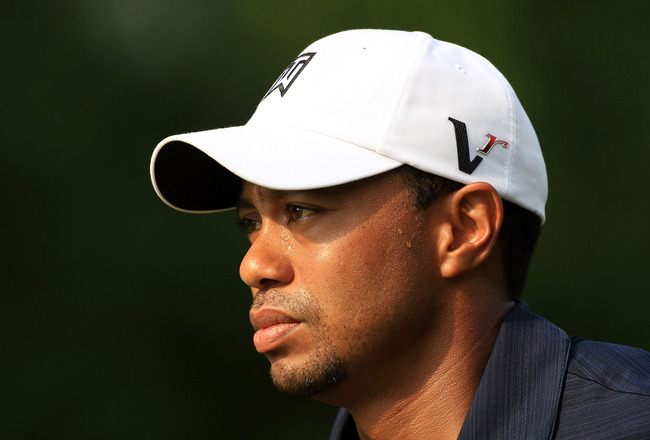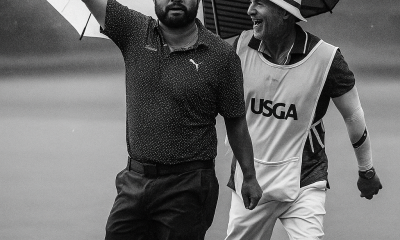Opinion & Analysis
Williams: The maturation of Tiger Woods

By Michael WIlliams
GolfWRX Staff Writer
An interesting phenomenon is sports, is that the greats often have styles of play that match their personalities. In team sports it is more truism than truth; the example that comes to mind is Larry Bird. Off the court, the man had all the personality of a bowl of oatmeal. But on the court he was a brazen, daring star who carried his team to victory on the shoulders of his outsized alter ego, Larry Legend.
But on tournament golf’s individual stage, where there are no teammates to stand behind or in front of, the axiom is proven time and time again. The player must not only craft a method for playing this devil of a game, he or she must also develop a personality to allow the method to function. If the swing is the lifeblood of a player’s success, it is the personality that provides the rock ribs necessary to attain success and the thick skin crucial surviving the stinging disappointments that are a part of the journey.
The way the player walks, talks, stands and even blinks are evidence of he player’s personality, and with no helmet or shoulder pads to provide confidence or camouflage the player’s character is on full display. Walter Hagen brought a sense of style and adventure to a gentleman’s game approaching his wardrobe and his approaches with equal flair. Ben Hogan practiced in a solitary world that he constructed for himself, locking others out while he searched for The Secret with OCD-like fervor. In the end, he found what he was looking for inside the perfectly controlled confines of his psyche. He drew millions close to him with the results his perfectionism; ironically, that same iron will created a wall that kept those adoring masses at a distance whether he truly wanted it or not. In sharp contrast is the unbridled charisma of Arnold Palmer. Win lose or draw, it was Arnie’s world and he knew it. The world bent to Palmer’s personal gravity in the same way that courses relented to his powerful draw. And is there any doubt that Seve Ballesteros was the original “Most Interesting Man in the World”? He smiled in the face of his self-made catastrophes and extricated himself from them with the same bootlegger’s grin.
Today’s tour provides more exhibits of the game/personality connection. Bubba Watson is a self-made man, simple and complex all at once. The same is true of his game; his holler-wallop swings producing parabolas seldom seen outside a NASA proving ground. Watson draws a unique path through the course, just as he does through life. Rory McIlroy is the baby-faced assassin, playing the game few in that prodigious style of someone who has never known anything except being exceptional. But his maturity at his tender age is what served him best, allowing him to shake off the disaster at Augusta and produce a gem at Congressional in the one tournament that requires equal part patience and performance.
Amid these constructions, Tiger Woods stands as a monument. For more than a decade he seemed to be a magical experiment that combined both the game and personality characteristics of golf’s greatest players into one anointed player. Nicklaus’ distance and ambition, Palmer’s strength and flair, Hogan’s determination and work ethic were all in display as Tiger’s star hurtled across the sky. He was even paid a king’s ransom to accept credit for characteristics that we weren’t even sure he possessed, all so that a corporate sponsor could apply those characteristics to their products by the transitive property (Tiger has integrity, we pay Tiger, therefore we have integrity).
The personal crash that Woods experienced led to exposition and seismic changes. The King was deposed, tried, convicted and publicly flayed. And then, there was change. We saw Tiger apologize. We saw him beaten. And a couple of inglorious times, it seemed as if we saw him surrender.
Entering the second act of his life and career, Tiger is piecing together a new way to play and a new way to live. At the Media Day for the AT&T National tournament that he will host at Congressional in late June, the talk was of Tiger’s calm and considered demeanor. The hubris was virtually gone. In its place was a quiet confidence and a genuine belief that the event was more about supporting the kids in his foundation than as a stepping stone to his return to the top. Tiger patiently sat for the media, spent time with kids form his foundation and had a 10-year old Down’s Syndrome boy he had befriended at a tournament last year sit next to him during the press conference. He even deigned to participate in a promotional chipping contest with local amateurs. We do not see or hear much about Tiger’s private life, but what we do know is that he has dived into role as a father with relish. He is still focused on Jack in the distance, but is not willing to leave his loved ones behind to reach him.
They say that getting chicken pox in adulthood is much worse that getting it as a child. In the same way, it is much harder to grow up when you’re an adult than it is to do it as a child. Tiger Woods maturation began at 34, in full view of half the planet. As the Memorial begins this week, Woods is also searching for a game to match a personality that is in flux. He needs to decide if he will be a cannon or a sniper rifle, a jazz riff or a metronome. But as he searches for the combination that works, he will be aided by one wonderful thing that is happening off the course; he is becoming more of a man. And the golf world is hoping that eventually it will lead to him becoming more of a golfer.
Click here for more discussion in the “Tour talk” forum.
Michael Williams is the contributing editor of Newschannel8 Capital Golf Weekly and Bunkershot.com, as well as a member of the Golf Writers Association of America.
You can follow Michael on twitter — @Michaelontv
Opinion & Analysis
The 2 primary challenges golf equipment companies face

As the editor-in-chief of this website and an observer of the GolfWRX forums and other online golf equipment discourse for over a decade, I’m pretty well attuned to the grunts and grumbles of a significant portion of the golf equipment purchasing spectrum. And before you accuse me of lording above all in some digital ivory tower, I’d like to offer that I worked at golf courses (public and private) for years prior to picking up my pen, so I’m well-versed in the non-degenerate golf equipment consumers out there. I touched (green)grass (retail)!
Complaints about the ills of and related to the OEMs usually follow some version of: Product cycles are too short for real innovation, tour equipment isn’t the same as retail (which is largely not true, by the way), too much is invested in marketing and not enough in R&D, top staffer X hasn’t even put the new driver in play, so it’s obviously not superior to the previous generation, prices are too high, and on and on.
Without digging into the merits of any of these claims, which I believe are mostly red herrings, I’d like to bring into view of our rangefinder what I believe to be the two primary difficulties golf equipment companies face.
One: As Terry Koehler, back when he was the CEO of Ben Hogan, told me at the time of the Ft Worth irons launch, if you can’t regularly hit the golf ball in a coin-sized area in the middle of the face, there’s not a ton that iron technology can do for you. Now, this is less true now with respect to irons than when he said it, and is less and less true by degrees as the clubs get larger (utilities, fairways, hybrids, drivers), but there remains a great deal of golf equipment truth in that statement. Think about it — which is to say, in TL;DR fashion, get lessons from a qualified instructor who will teach you about the fundamentals of repeatable impact and how the golf swing works, not just offer band-aid fixes. If you can’t repeatably deliver the golf club to the golf ball in something resembling the manner it was designed for, how can you expect to be getting the most out of the club — put another way, the maximum value from your investment?
Similarly, game improvement equipment can only improve your game if you game it. In other words, get fit for the clubs you ought to be playing rather than filling the bag with the ones you wish you could hit or used to be able to hit. Of course, don’t do this if you don’t care about performance and just want to hit a forged blade while playing off an 18 handicap. That’s absolutely fine. There were plenty of members in clubs back in the day playing Hogan Apex or Mizuno MP-32 irons who had no business doing so from a ballstriking standpoint, but they enjoyed their look, feel, and complementary qualities to their Gatsby hats and cashmere sweaters. Do what brings you a measure of joy in this maddening game.
Now, the second issue. This is not a plea for non-conforming equipment; rather, it is a statement of fact. USGA/R&A limits on every facet of golf equipment are detrimental to golf equipment manufacturers. Sure, you know this, but do you think about it as it applies to almost every element of equipment? A 500cc driver would be inherently more forgiving than a 460cc, as one with a COR measurement in excess of 0.83. 50-inch shafts. Box grooves. And on and on.
Would fewer regulations be objectively bad for the game? Would this erode its soul? Fortunately, that’s beside the point of this exercise, which is merely to point out the facts. The fact, in this case, is that equipment restrictions and regulations are the slaughterbench of an abundance of innovation in the golf equipment space. Is this for the best? Well, now I’ve asked the question twice and might as well give a partial response, I guess my answer to that would be, “It depends on what type of golf you’re playing and who you’re playing it with.”
For my part, I don’t mind embarrassing myself with vintage blades and persimmons chasing after the quasi-spiritual elevation of a well-struck shot, but that’s just me. Plenty of folks don’t give a damn if their grooves are conforming. Plenty of folks think the folks in Liberty Corner ought to add a prison to the museum for such offences. And those are just a few of the considerations for the amateur game — which doesn’t get inside the gallery ropes of the pro game…
Different strokes in the game of golf, in my humble opinion.
Anyway, I believe equipment company engineers are genuinely trying to build better equipment year over year. The marketing departments are trying to find ways to make this equipment appeal to the broadest segment of the golf market possible. All of this against (1) the backdrop of — at least for now — firm product cycles. And golfers who, with their ~15 average handicap (men), for the most part, are not striping the golf ball like Tiger in his prime and seem to have less and less time year over year to practice and improve. (2) Regulations that massively restrict what they’re able to do…
That’s the landscape as I see it and the real headwinds for golf equipment companies. No doubt, there’s more I haven’t considered, but I think the previous is a better — and better faith — point of departure when formulating any serious commentary on the golf equipment world than some of the more cynical and conspiratorial takes I hear.
Agree? Disagree? Think I’m worthy of an Adam Hadwin-esque security guard tackle? Let me know in the comments.
@golfoncbs The infamous Adam Hadwin tackle ? #golf #fyp #canada #pgatour #adamhadwin ? Ghibli-style nostalgic waltz – MaSssuguMusic
Podcasts
Fore Love of Golf: Introducing a new club concept

Episode #16 brings us Cliff McKinney. Cliff is the founder of Old Charlie Golf Club, a new club, and concept, to be built in the Florida panhandle. The model is quite interesting and aims to make great, private golf more affordable. We hope you enjoy the show!
Opinion & Analysis
On Scottie Scheffler wondering ‘What’s the point of winning?’

Last week, I came across a reel from BBC Sport on Instagram featuring Scottie Scheffler speaking to the media ahead of The Open at Royal Portrush. In it, he shared that he often wonders what the point is of wanting to win tournaments so badly — especially when he knows, deep down, that it doesn’t lead to a truly fulfilling life.
View this post on Instagram
“Is it great to be able to win tournaments and to accomplish the things I have in the game of golf? Yeah, it brings tears to my eyes just to think about it because I’ve literally worked my entire life to be good at this sport,” Scheffler said. “To have that kind of sense of accomplishment, I think, is a pretty cool feeling. To get to live out your dreams is very special, but at the end of the day, I’m not out here to inspire the next generation of golfers. I’m not out here to inspire someone to be the best player in the world, because what’s the point?”
Ironically — or perhaps perfectly — he went on to win the claret jug.
That question — what’s the point of winning? — cuts straight to the heart of the human journey.
As someone who’s spent over two decades in the trenches of professional golf, and in deep study of the mental, emotional, and spiritual dimensions of the game, I see Scottie’s inner conflict as a sign of soul evolution in motion.
I came to golf late. I wasn’t a junior standout or college All-American. At 27, I left a steady corporate job to see if I could be on the PGA Tour starting as a 14-handicap, average-length hitter. Over the years, my journey has been defined less by trophies and more by the relentless effort to navigate the deeply inequitable and gated system of professional golf — an effort that ultimately turned inward and helped me evolve as both a golfer and a person.
One perspective that helped me make sense of this inner dissonance around competition and our culture’s tendency to overvalue winning is the idea of soul evolution.
The University of Virginia’s Division of Perceptual Studies has done extensive research on reincarnation, and Netflix’s Surviving Death (Episode 6) explores the topic, too. Whether you take it literally or metaphorically, the idea that we’re on a long arc of growth — from beginner to sage elder — offers a profound perspective.
If you accept the premise literally, then terms like “young soul” and “old soul” start to hold meaning. However, even if we set the word “soul” aside, it’s easy to see that different levels of life experience produce different worldviews.
Newer souls — or people in earlier stages of their development — may be curious and kind but still lack discernment or depth. There is a naivety, and they don’t yet question as deeply, tending to see things in black and white, partly because certainty feels safer than confronting the unknown.
As we gain more experience, we begin to experiment. We test limits. We chase extreme external goals — sometimes at the expense of health, relationships, or inner peace — still operating from hunger, ambition, and the fragility of the ego.
It’s a necessary stage, but often a turbulent and unfulfilling one.
David Duval fell off the map after reaching World No. 1. Bubba Watson had his own “Is this it?” moment with his caddie, Ted Scott, after winning the Masters.
In Aaron Rodgers: Enigma, reflecting on his 2011 Super Bowl win, Rodgers said:
“Now I’ve accomplished the only thing that I really, really wanted to do in my life. Now what? I was like, ‘Did I aim at the wrong thing? Did I spend too much time thinking about stuff that ultimately doesn’t give you true happiness?’”
Jim Carrey once said, “I think everybody should get rich and famous and do everything they ever dreamed of so they can see that it’s not the answer.”
Eventually, though, something shifts.
We begin to see in shades of gray. Winning, dominating, accumulating—these pursuits lose their shine. The rewards feel more fleeting. Living in a constant state of fight-or-flight makes us feel alive, yes, but not happy and joyful.
Compassion begins to replace ambition. Love, presence, and gratitude become more fulfilling than status, profits, or trophies. We crave balance over burnout. Collaboration over competition. Meaning over metrics.
Interestingly, if we zoom out, we can apply this same model to nations and cultures. Countries, like people, have a collective “soul stage” made up of the individuals within them.
Take the United States, for example. I’d place it as a mid-level soul: highly competitive and deeply driven, but still learning emotional maturity. Still uncomfortable with nuance. Still believing that more is always better. Despite its global wins, the U.S. currently ranks just 23rd in happiness (as of 2025). You might liken it to a gifted teenager—bold, eager, and ambitious, but angsty and still figuring out how to live well and in balance. As much as a parent wants to protect their child, sometimes the child has to make their own mistakes to truly grow.
So when Scottie Scheffler wonders what the point of winning is, I don’t see someone losing strength.
I see someone evolving.
He’s beginning to look beyond the leaderboard. Beyond metrics of success that carry a lower vibration. And yet, in a poetic twist, Scheffler did go on to win The Open. But that only reinforces the point: even at the pinnacle, the question remains. And if more of us in the golf and sports world — and in U.S. culture at large — started asking similar questions, we might discover that the more meaningful trophy isn’t about accumulating or beating others at all costs.
It’s about awakening and evolving to something more than winning could ever promise.





















